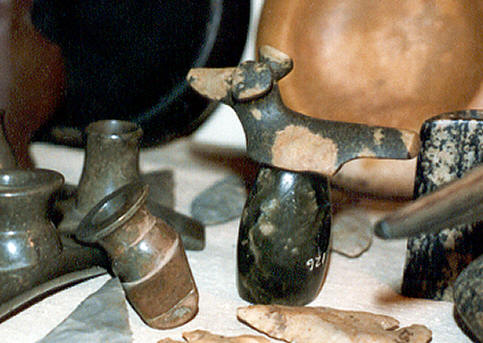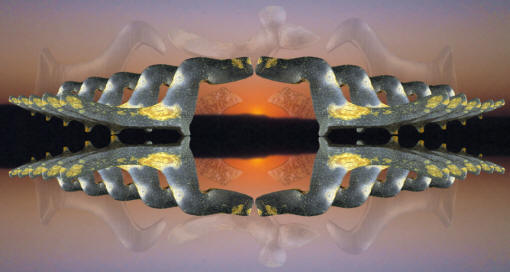|
"The probability--is that these
bird-stones were used or worn by the men rather than by the women, and
Cushing's theory that they were attached to a plate and fixed to the
hair is plausible."---1919,
Frederick Webb Hodge, "Bird-Stones," Handbook of American
Indians North Of Mexico, part 1, p. 148.
"Gillman was informed by an aged Chippewa,
"that in olden time these ornaments were worn on the heads of Indian
women, but only after marriage," and suggests that the birdstones may
have symbolized the brooding bird."---1919,
Frederick Webb Hodge, "Bird-Stones," Handbook of American
Indians North Of Mexico, part 1, p. 148-149.
"It may reasonably be concluded from the
uniform shape of these (birdstones)
articles, and from their apparent unfitness as implements, as also from
the wide range of their occurrence, that they were invested with a
conventional significance as insignia or badges of distinction or as
amulets"---1848,
E. G. Squier and E. H. Davis, "Ornaments Of Stone, Bone, Etc.,"
Ancient Monuments Of The Mississippi Valley, p. 239.
"The underside (of
birdstones) is flat or slightly
concave, and there are two perforations at the extremities of the base
intended to serve in attaching the figure to the surface of some object,
as a tablet, a pipe stem, a flute, or a staff or baton, or some part of
the costume, or to the hair."---1919,
Frederick Webb Hodge, "Bird-Stones," Handbook of American
Indians North Of Mexico, part 1, p. 148.
"They (birdstones)
appear in two types, the plain bar; called bar amulet, or with the upper
face more or less resembling a sitting bird, with an expanded tail, and
head with projecting eyes, called bird amulet."---1898,
Frederick H. Williams, M.D.,
"Amulets," The American Archaeologist, Vol. 2, No. 8,
pp. 200-202.
"While they (birdstones)
bear a greater resemblance to birds than any thing else, yet scarcely
any two of them are alike, and they change in form through the whole
gamut until it is difficult to determine whether it is a bird, a lizard,
or a turtle, and finally the series ends in a straight bar without
pretense of representing any animal."---1896,
Thomas Wilson,
"Prehistoric Art; Or The Origin Of Art As Manifested In The Works
Of Prehistoric Man," Report Of The U.S. National Museum, p.
450.

BIRDSTONES
EASTERN UNITED STATES
LATE ARCHAIC TO EARLY WOODLAND PERIOD
The earliest writers have always referred to these abstract images in
stone as bird effigies. Most people have no problem
identifying them with birds even though they are found in many different
abstract or highly stylized forms. For more than 150 years they have been referred to as
birds, bird shaped objects, bird amulets and finally the descriptive
term used today, birdstones.
|
|

ILLUSTRATION FROM 1848
SMITHSONIAN PUBLICATION
BIRDSTONES
EASTERN UNITED STATES
These three drawings represent some of the earliest illustrations of
birdstones. They were published in 1848 in
Squier and Davis's, "Ancient Monuments Of The Mississippi Valley."
The first publication by the Smithsonian. |
|
|
No one knows
what birdstones were used for. Absolute proof of what their drilled
holes and flat undersurfaces were attached to has never been found. But
there are many suggestions. Most of these ideas originate from different cultural artifacts that seem to have a similar theme
or shape and were used in either ceremonial or utilitarian applications.
Some of these suggestions are: they were attached to the prow of canoes,
mounted on staffs, attached to flutes, used as atlatl weights, used as
atlatl handle grips, attached to long smoking pipe stems, or that they may
represent fetishes or talismans that were fastened to such things as
games bags or arrow quivers, or that they may represent effigies of duck
decoys and even that they may have been carried by medicine men. |
|
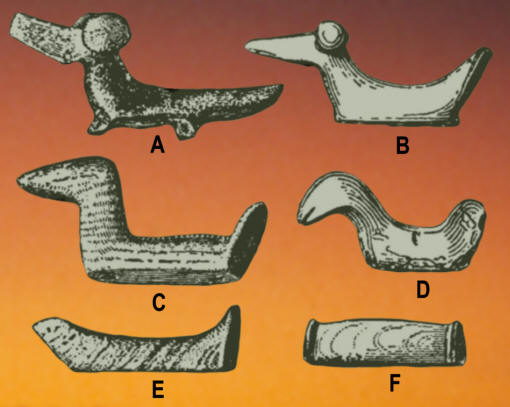
ILLUSTRATION FROM 1912
SMITHSONIAN PUBLICATION
BIRDSTONES
EASTERN UNITED STATES
LATE ARCHAIC
These six drawings of birdstones illustrate
several of the different "main" forms. The two birdstones at top
represent one of the most elaborate types. Both have popeyes but one
has feet and the other does not. The next two represent the most
common style. One has a short body and the other is the elongated
form. Notice also that one has a mouth and the other does not. One
survey of 1,000 birdstones showed that 10.7% had incised mouths. The
two bottom examples are the simplest forms of birdstones. The
example on the left still has a recognizable head and tail but the
example on the right only has two raised ridges to represent the
head and tail. The one on the right is also referred to as a bar
amulet.
Birdstones have been found in an endless variety of form. Dr.
Thomas Wilson is quoted in Moorhead 1917: "The United States
National Museum posses many of these specimens (birdstones). While
they bear a greater resemblance to birds than anything else , yet
scarcely any two of them are alike and they change in form through
the whole gamut until it is difficult to determine whether it is a
bird, a lizard, or a turtle, and finally the series ends in a
straight bar without pretense of presenting any animal." |
|
|
Birdstones
date from the Late Archaic to the Early Woodland
periods. Only a handful of them have been found during the excavation of
burials. Two bar style birdstones are reported to have been found in the
head area of a single adult on the Baker II Late Archaic site in
Sandusky County, Ohio. The Baker II site dates to the terminal
Late Archaic period at 2,820 years ago. A popeyed style birdstone is also
reported to have been found during the excavation of an Early Woodland
burial containing three individuals on the Danbury site in northern Ohio
dating to around 2,500 years ago. Bust type birdstones have also been
reported from Early Woodland Adena mounds. Birdstones are also
associated with Glacial Kame sites. |
|
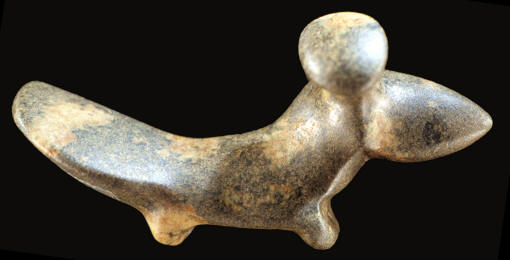
CLICK ON PICTURE FOR LARGER IMAGE
POPEYED BIRDSTONE
HANCOCK
COUNTY, OHIO
This popeyed birdstone was found in 1926 by J. D. Alspach in Hancock, County
near Vanlue, Ohio. It represents one of the more artistic forms and
has the more rarely seen addition of "feet." Most birdstones do not
have any projection on the bottom but instead have smooth flat
undersides. They are also drilled on the front and back corners indicating they
were once attached to some object. This birdstone is drilled through
both "feet." The hole in front can be seen in this picture. This
birdstone is made of porphyry and measures 3 1/4 inches (8.2 cm)
long.
The extra effort that is applied by the sculptor to enhance the
eyes of these types of birdstones would seem to suggest an intention
to convey strength in vision. One interpretative concept of this
train of thought might be, the more powerful the eye sight the more
knowledge that can be possessed, delivered or conveyed. |
|
|
There are three basic styles of birdstones which evolved into many
different distinct types. The more common type is known as the elongated
form. They are usually made of banded slate, have long
bodies with long "beaks," and have no eyes. The saddle form is another type. It has eyes
and is usually made of porphyry or granite. The third and rarest form is
the bust type. This type has no body except for a head neck and
shoulders. They are often made from some of the hardest stone, such as
granite or quartz. |
|
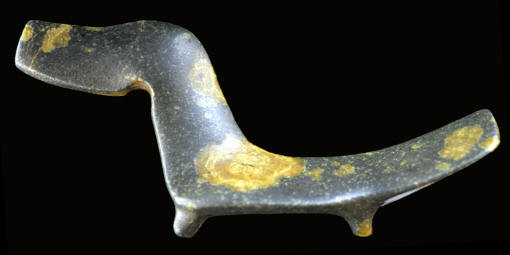
CLICK ON PICTURE FOR LARGER IMAGE
FANTAIL BIRDSTONE
CHITTENDEN COUNTY, VERMONT
This fantail birdstone was found in
1846 by S. H. Baker in Chittenden County one mile north of
Burlington, Vermont. This is another of the more rare and beautiful
forms of birdstones. It was made from a colorful stone and its
complex style includes "feet," a large rectangular head, and wide
tail. It's also drilled through both "feet." This birdstone is
made of porphyry and
measures 4 1/2 inches (11.4 cm) long. |
|
|
Birdstones have been found in many states east of the
Mississippi River and in an area in southeastern Canada. More
specifically, approximately 95% of them have been found in New York,
Pennsylvania, Ohio, Indiana, Illinois, Wisconsin, Michigan and in the lower
region of
eastern Canada. The greatest number of birdstones have been found in
Ohio and Michigan. The state of Indiana has produced the third largest
number. The core area where most birdstones have been found is located
in northeastern Indiana, northwestern Ohio, southeastern Michigan and
the southern part of Ontario. |
|
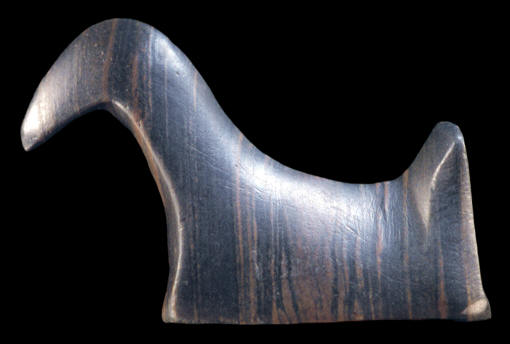
SHORT BODY BIRDSTONE
EASTERN UNITED STATES
This banded slate birdstone represents one of the more common short
body styles. Most birdstones were made of banded slate. This birdstone is drilled at the bottom corners at the front
and back and it has the typical flat bottom. |
|
|
Birdstones were made from several different types of hard and soft
stone. By far the largest number, in fact most of them, are made from
banded greenish gray slate. Birdstones were also made from: different
forms of granite, porphyry, quartzite, quartz, diorite, gneiss,
serpentine, hematite, soapstone, sandstone, limestone, shale, indurate
clay and Ohio pipestone. |
|

CLICK ON PICTURE FOR LARGER IMAGE
BUST BIRDSTONE
ERIE COUNTY, OHIO
This bust birdstone was found in 1977 by Earl Devereaux on a small
shale bar in the Huron River in Erie County near Milan, Ohio. Bust
birdstones are the rarest type. Only the head, neck and shoulder are
represented, unlike most birdstones which have full bodies. Bust
birdstones are also often made from harder stones. This birdstone is
made of granite and measures 3 3/16 inches (8.1 cm) long.
Bust birdstones are the most recently made types. They date to the
Early Woodland period and have been found on Adena sites. |
|
|
Birdstones represent one of the most impressively crafted
ground stone artifacts found in North America. The fact that they were
made from durable materials suggests that these were important objects.
The more elaborate popeyed, fantail or long bodied styles would have
required a fair amount of skill and time to make them. |
|
CONTINUE ON TO PAGE
TWO
|
|
"REFERENCES"
1848, Squier, E. G. & Davis, E. H., "Ornaments Of Stone, Bone, Etc.,"
Ancient Monuments Of The Mississippi Valley, p. 239.
1896, Wilson, Thomas, "Prehistoric Art; Or The Origin Of Art As
Manifested In The Works Of Prehistoric Man," Report Of The U.S. National Museum, p.
450.
1898, Williams, Frederick H. M.D., "Amulets," The American Archaeologist, Vol. 2, No. 8,
pp. 200-202.
1912, Hodge, Frederick Webb, "Bird-Stones," Handbook Of American
Indians North Of Mexico, pp. 148-149.
1917, Moorhead, Warren K., "Stone Ornaments Used By Indians In
The United States And Canada," p. 88.
1959, Townsend, Earl C., "Birdstones Of The North American
Indian," pp. 3.
1975, Tiell, William W., "The Incised Mouth Birdstone," Ohio
Archaeologist, Vol. 25, No. 3, pp. 20 -21.
1979, Fincham, Glenval, "A Novel Explanation Of The Origin And
Development Of The Birdstone," Ohio Archaeologist, Vo. 29, No. 4,
p p. 14-15.
1984, Illustration, "Central States Archaeological Journal,
Vol. 31, No. 3" p. 135.
1993, Zakucia, John A., "The Birdstone, An Enigma Of The Prehistoric
Past," Ohio Archaeologist, Vol. 43, No. 1, p. 27.
2003, Skrivanie, Oliver T., "The Fab Five," Prehistoric American,
Vol.37, No. 2, p. 4.
2004, Power, Susan C., "Early Art Of The Southeastern Indians
Feathered Serpents & Winged Beings," p. 28.
2006, Werness, Hope B., "Bird," Animal Symbolism In Art, p.
44.
Personal Communication, Dennis Vesper.
Clem Caldwell Collection Pictures, Dennis Vesper.
|
|
RECENT
LISTINGS HOME
ORDERING |
